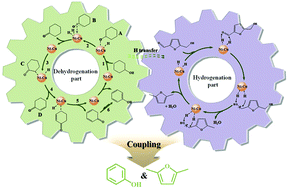当前位置:
X-MOL 学术
›
Green Chem.
›
论文详情
Our official English website, www.x-mol.net, welcomes your
feedback! (Note: you will need to create a separate account there.)
Highly efficient synchronized production of phenol and 2,5-dimethylfuran through a bimetallic Ni–Cu catalyzed dehydrogenation–hydrogenation coupling process without any external hydrogen and oxygen supply
Green Chemistry ( IF 9.3 ) Pub Date : 2017-07-28 00:00:00 , DOI: 10.1039/c7gc01387f Wei Li 1, 2, 3, 4, 5 , Guoli Fan 1, 2, 3, 4, 5 , Lan Yang 1, 2, 3, 4, 5 , Feng Li 1, 2, 3, 4, 5
Green Chemistry ( IF 9.3 ) Pub Date : 2017-07-28 00:00:00 , DOI: 10.1039/c7gc01387f Wei Li 1, 2, 3, 4, 5 , Guoli Fan 1, 2, 3, 4, 5 , Lan Yang 1, 2, 3, 4, 5 , Feng Li 1, 2, 3, 4, 5
Affiliation

|
2,5-Dimethylfuran (DMF) and phenol are considered as one of the new-fashioned liquid transportation biofuels and a key motif for industrial chemicals, respectively. Herein, a highly efficient vapor-phase dehydrogenation–hydrogenation coupling process over bimetallic Ni–Cu alloy nanocatalysts was established for the synchronized production of phenol and DMF with unprecedentedly high yields (>97%) from two cyclohexanol (CHL) and biomass-derived 5-hydroxymethylfurfural (HMF) substrates, without any external hydrogen and oxygen supply. Systematic characterization and catalytic experiments revealed that the production of phenol went through a consecutive triple-dehydrogenation process from CHL, while HMF was simultaneously hydrogenated into DMF using active hydrogen species generated from the dehydrogenation process. The bimetallic Ni–Cu alloy nanostructures derived from Ni–Cu–Al layered double hydroxide precursors and strong metal–support interactions play important roles in governing the present coupling process. An appropriate Ni–Cu alloy nanostructure could greatly facilitate the dehydrogenative aromatization of CHL, thus significantly improving the selectivities to both phenol and DMF. Such an unparalleled efficient, eco-friendly and versatile coupling process for the synchronized production of various substituted phenols and DMF makes it practically promising for large-scale industrial applications in terms of green chemistry and sustainable development.
中文翻译:

通过双金属镍-铜催化的脱氢-加氢偶联过程高效同步生产苯酚和2,5-二甲基呋喃,无需任何外部氢和氧供应
2,5-二甲基呋喃(DMF)和苯酚分别被视为新型的液体运输生物燃料之一和工业化学品的关键主题。在此,建立了一种在双金属Ni-Cu合金纳米催化剂上的高效气相脱氢-氢化偶联工艺,用于从两种环己醇(CHL)和生物质衍生的原料中同步生产苯酚和DMF,具有前所未有的高产率(> 97%)5 -羟甲基糠醛(HMF)底物,无需任何外部氢气和氧气供应。系统表征和催化实验表明,苯酚的生产经历了连续的三重脱氢过程,而HMF则利用脱氢过程中产生的活性氢物质同时被氢化成DMF。由Ni-Cu-Al层状双氢氧化物前体和强金属-载体相互作用衍生的双金属Ni-Cu合金纳米结构在控制当前的偶联过程中起着重要作用。合适的Ni-Cu合金纳米结构可以极大地促进CHL的脱氢芳构化,从而显着提高对苯酚和DMF的选择性。这种无与伦比的高效,环保和通用的偶联工艺可用于同步生产各种取代的苯酚和DMF,因此从绿色化学和可持续发展的角度看,在大规模工业应用中具有实际的应用前景。合适的Ni-Cu合金纳米结构可以极大地促进CHL的脱氢芳构化,从而显着提高对苯酚和DMF的选择性。这种无与伦比的高效,环保和通用的偶联工艺可用于同步生产各种取代的苯酚和DMF,因此从绿色化学和可持续发展的角度看,在大规模工业应用中具有实际的应用前景。合适的Ni-Cu合金纳米结构可以极大地促进CHL的脱氢芳构化,从而显着提高对苯酚和DMF的选择性。这种无与伦比的高效,环保和通用的偶联工艺可用于同步生产各种取代的苯酚和DMF,因此从绿色化学和可持续发展的角度看,在大规模工业应用中具有实际的应用前景。
更新日期:2017-09-19
中文翻译:

通过双金属镍-铜催化的脱氢-加氢偶联过程高效同步生产苯酚和2,5-二甲基呋喃,无需任何外部氢和氧供应
2,5-二甲基呋喃(DMF)和苯酚分别被视为新型的液体运输生物燃料之一和工业化学品的关键主题。在此,建立了一种在双金属Ni-Cu合金纳米催化剂上的高效气相脱氢-氢化偶联工艺,用于从两种环己醇(CHL)和生物质衍生的原料中同步生产苯酚和DMF,具有前所未有的高产率(> 97%)5 -羟甲基糠醛(HMF)底物,无需任何外部氢气和氧气供应。系统表征和催化实验表明,苯酚的生产经历了连续的三重脱氢过程,而HMF则利用脱氢过程中产生的活性氢物质同时被氢化成DMF。由Ni-Cu-Al层状双氢氧化物前体和强金属-载体相互作用衍生的双金属Ni-Cu合金纳米结构在控制当前的偶联过程中起着重要作用。合适的Ni-Cu合金纳米结构可以极大地促进CHL的脱氢芳构化,从而显着提高对苯酚和DMF的选择性。这种无与伦比的高效,环保和通用的偶联工艺可用于同步生产各种取代的苯酚和DMF,因此从绿色化学和可持续发展的角度看,在大规模工业应用中具有实际的应用前景。合适的Ni-Cu合金纳米结构可以极大地促进CHL的脱氢芳构化,从而显着提高对苯酚和DMF的选择性。这种无与伦比的高效,环保和通用的偶联工艺可用于同步生产各种取代的苯酚和DMF,因此从绿色化学和可持续发展的角度看,在大规模工业应用中具有实际的应用前景。合适的Ni-Cu合金纳米结构可以极大地促进CHL的脱氢芳构化,从而显着提高对苯酚和DMF的选择性。这种无与伦比的高效,环保和通用的偶联工艺可用于同步生产各种取代的苯酚和DMF,因此从绿色化学和可持续发展的角度看,在大规模工业应用中具有实际的应用前景。











































 京公网安备 11010802027423号
京公网安备 11010802027423号